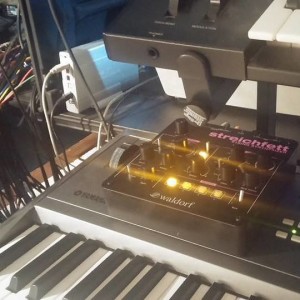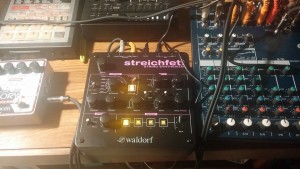Two-thirds of the way through recording my new Church of Hed album, I thought some tracks needed a bit of icing. I previously noted Waldorf’s new Streichfett string synthesizer; digested some online sound samples, and felt confident it would serve nicely in this role. After discovering its street price was under $400, I decided to make my move.
Needless to say, the Streichfett is a beast; providing powerful, yet milky, sonic textures to frighten the rest of my synth gear, including the Moog Sub 37. In short, it is the most “analog” of my digital synthesizers. Oh, Streichfett apparently is German for “spreading fat.” Indeed.
Waldorf’s Square String Synth
The Streichfett is housed in the square casing typical of Waldorf’s other desktop synth modules. Thankfully, this small footprint lets it reside comfortably on top of my Yamaha MM8. Since the thing sounds so huge, only a few notes are needed to cut through a mix, leaving your left hand free for real-time tweaking.

An array of knobs and switches control the synth’s straightforward architecture, while four buttons and a switch navigate the unit’s 12 memory locations. Speaking of which, since it’s so easy to dial up sounds on the Streichfett, I found myself rarely using memory to save or recall patches. It really is an “analog” digital synth from a control standpoint.
Two sections make up a Streichfett patch. The Strings provide the meat of the sound, while the Solo section offers extra “percussive” color suitable for melodic lines or arpeggios, not unlike the percussion setting on an organ. The balance knob mixes these two sections.
The Registration knob in the Strings section selects between different sounds — everything from violin to choir. It also provides some really cool effects when controlled in real-time — the synth’s Animate effect does essentially the same thing powered by an LFO. Two knobs control the envelope, and Waldorf recommends always keeping the Ensemble button lit. Turning it off makes the Streichfett sound like a bad 80s synth.

The Solo section’s main knob switches from bass to Pluto — the latter being a typical outer space synth tone. Tremolo and envelope controls round out this section, along with a switch to control the keyboard split. In addition to the previously mentioned Animate effect, there are also Phaser and Reverb effects, with a depth knob offering a variety of intuitive control options for all three.
In short, the Streichfett is a synth you simply need to dive in, tweak, and have fun. The patch memory is nice for saving ideas when dinner is ready, but it isn’t essential.
The Atmans swim in the Lunar Sea
Sonically, the Streichfett stuns. I am not well-versed enough in the specific sound differences of the 70s-era string synths like the Solina or Roland to say Waldorf’s modern version emulates any model more accurately than another. I can say if your prog rock cover band does Kansas’s Incomurdo — Hymn to the Atman or Camel’s Lunar Sea — you need this synth. Pink Floyd’s Shine on you Crazy Diamond and most mid-70s porn music are right in the Streichfett’s wheelhouse as well. Boom.
If you are looking for a unique synth to add a bit creamy froth to your work, put the Waldorf Streichfett on your wish list. Highly recommended.



Pingback: Recording Digest: Church of Hed -- Brandenburg Heights | TabMuse -- a Home for Digital and Analog Music Inspiration
Pingback: PolyM offers a Great Polymoog Emulation | TabMuse -- a Home for Digital and Analog Music Inspiration
Pingback: The Best New Synths from NAMM 2018 | TabMuse -- a Home for Digital and Analog Music Inspiration